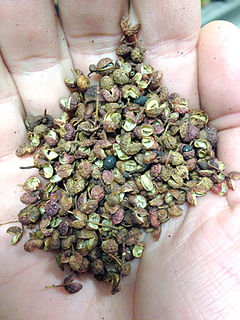
Sichuan cuisine, alternatively romanized as Szechwan cuisine or Szechuan cuisine, is a style of Chinese cuisine originating from Sichuan Province. It has bold flavours, particularly the pungency and spiciness resulting from liberal use of garlic and chili peppers, as well as the unique flavour of Sichuan pepper. There are many local variations within Sichuan Province and the neighbouring Chongqing Municipality, which was part of Sichuan Province until 1997. Four sub-styles of Sichuan cuisine include Chongqing, Chengdu, Zigong and Buddhist vegetarian style.

Sichuan is a landlocked province in Southwest China occupying most of the Sichuan Basin and the easternmost part of the Tibetan Plateau between the Jinsha River on the west, the Daba Mountains in the north, and the Yungui Plateau to the south. Sichuan's capital city is Chengdu. The population of Sichuan stands at 81 million.

The red underwing is a moth of the family Erebidae. The species was first described by Carl Linnaeus in his 1767 12th edition of Systema Naturae.
Sichuan Airlines Co., Ltd. is a Chinese airline based in Chengdu Shuangliu International Airport in Chengdu, Sichuan Province, and is the largest airline in western China, operating mainly scheduled domestic and international flights out of Chengdu Shuangliu Airport, Chongqing Jiangbei International Airport and Kunming Changshui International Airport.

The Sichuan Basin, formerly transliterated as the Szechwan Basin, sometimes called the Red Basin, is a lowland region in southwestern China. It is surrounded by mountains on all sides and is drained by the upper Yangtze River and its tributaries. The basin is anchored by Chengdu, capital of Sichuan province, in the west, and the direct-administered municipality of Chongqing in the east. Due to its relative flatness and fertile soils, it is able to support a population of more than 100 million. In addition to being a dominant geographical feature of the region, the Sichuan Basin also constitutes a cultural sphere that is distinguished by its own unique customs, cuisine and dialects. It is famous for its rice cultivation and is often considered the breadbasket of China. In the 21st century its industrial base is expanding with growth in the high-tech, aerospace, and petroleum industries.

Catocala is a generally Holarctic genus of moths in the family Erebidae. The genus was erected by Franz von Paula Schrank in 1802. The moths are commonly known as underwing moths or simply underwings. These terms are sometimes used for a few related moths, but usually – especially when used in plural, not as part of a species name – they are used to refer to Catocala only.

The 2008 Sichuan earthquake, also known as the Great Sichuan earthquake or Wenchuan earthquake, occurred at 14:28:01 China Standard Time on May 12, 2008. Measuring at 8.0 Ms, the earthquake's epicenter was located 80 kilometres (50 mi) west-northwest of Chengdu, the provincial capital, with a focal depth of 19 km (12 mi). The earthquake ruptured the fault for over 240 km (150 mi), with surface displacements of several meters. The earthquake was also felt in nearby countries and as far away as both Beijing and Shanghai—1,500 and 1,700 km away, respectively—where office buildings swayed with the tremor. Strong aftershocks, some exceeding 6 Ms, continued to hit the area up to several months after the main shock, causing further casualties and damage. The earthquake also caused the largest number of geohazards ever recorded, including about 200,000 landslides and more than 800 quake lakes distributed over an area of 110,000 km2 (42,000 sq mi).

Catocala fulminea, the yellow bands underwing, is a moth of the family Erebidae. The species was first described by Giovanni Antonio Scopoli in his 1763 Entomologia Carniolica. It is found in central and southern Europe, east Asia and Siberia. The xarippe lineage has been proposed to be a distinct and valid species in its own right, instead of being only subspecifically distinct.

Catocala columbina is a moth of the family Erebidae. It is found in Sichuan, Chekiang, Taiwan and Japan.

Catocala agitatrix is a moth of the family Erebidae. It is found in the Russian Far East, China, Korea, Japan.
Catocala seiohbo is a moth of the family Erebidae first described by Katsumi Ishizuka in 2002. It is found in the Chinese provinces of Sichuan, Guangxi, Guangdong and Hunan.

Catocala kuangtungensis is a moth of the family Erebidae. It is found in China and Japan.

Catocala dejeani is a moth of the family Erebidae first described by Rudolf Mell in 1936. It is found in China and Taiwan.
Catocala ellamajor is a moth in the family Erebidae. It is found in China (Sichuan).
Catocala kasenko is a moth in the family Erebidae. It is found in China (Sichuan).
Catocala lehmanni is a moth in the family Erebidae. It is found in China (Sichuan).
Catocala borthi is a moth in the family Erebidae. It is found in China (Sichuan).
Catocala uljanae is a moth in the family Erebidae. It is found in China (Sichuan).

Kung Pao chicken, also transcribed Gong Bao or Kung Po, is a spicy, stir-fried Chinese dish made with cubes of chicken, peanuts, vegetables, and chili peppers. The classic dish in Sichuan cuisine originated in the Sichuan Province of south-western China and includes Sichuan peppercorns. Although the dish is found throughout China, there are regional variations that are typically less spicy than the Sichuan serving. Kung Pao chicken is also a staple of Westernized Chinese cuisine.

Sichuan pepper is a spice commonly used in the Sichuan cuisine of China's southwestern Sichuan Province. When eaten it produces a tingling, numbing effect due to the presence of hydroxy-alpha sanshool in the peppercorn. It is commonly used in Sichuan dishes such as mapo doufu and Chongqing hot pot, and is often added together with chili peppers to create a flavor known as málà.










